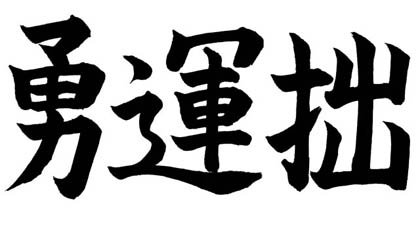Kendo Reader – Noma Hisashi
Kendo reader – English sample:
“Nowadays, apart from the unique situations that arise in times of war, there are almost no opportunities for us to cross swords in mortal combat. In place of the sword there are now more advanced and efficient weapons available. Consequently, to say that the aim of Kendo is “to destroy the enemy and to protect oneself” is naturally going to invite ridicule for such an outmoded idea.
No, within Kendo there is something to be sought of much greater value, something of profound spiritual significance. But to learn of this significance one cannot bypass the original function of Kendo as Bujutsu i.e. “to destroy the enemy and protect oneself”. It is only through a deadly earnest razor edged course of Kendo training that one can truly experience the lofty way towards spiritual understanding.
To class Kendo as merely another form of physical exercise is to view it as another form of sport and to that I think is to miss the mark completely. Having said that, I do not want it to appear that I do not acknowledge the excellent attributes that sport has to offer, not only from the physical aspect but also the spiritual aim. It is just that Budo was devised for and deployed in situations where ones life itself was at risk. For this crucial reason it differs greatly from sport, and it is on this point that the true value of Budo is to be found. Therefore, I must emphasise strongly that if one ignores the original function of Kendo as Bujutsu, where life and death are held in balance, then one greatly diminishes the value of Kendo. Although it is quite all right to view Kendo in the light of physical exercise and character cultivation , if any situation one forgets the primary role of Bujutsu one will not be able to comprehend the true meaning of Kendo. As was said earlier, in the present age there are practically no opportunities for mortal combat with a sword (shinken shobu). If that is the case how is one to come even close to experiencing the mental state on shinken shobu, of bringing Kendo to life as Bujutsu? The answer is to attach great importance to the outcome of one to one engagements (shohai). In Budo, shohai must be held in the highest regard. Questions of shohai may have to be set aside for purposes of instruction and so on by shohai is the difference between life and death, be it with the real sword or the shinai. It is vital to realise that to be defeated means that ones life is lost.”
Kendo reader – French sample:
“De nos jours, en dehors des situations uniques qui se posent en temps de guerre, il n’y a plus aucune possibilités de croiser le fer dans un combat mortel. En lieu et place de l’épée il ya maintenant plus sophistiquées et plus efficaces comme armes disponibles. Par conséquent, dire que le but du Kendo est de «détruire l’ennemi et de se protéger” va naturellement inviter le ridicule d’une telle idée dépassée.
Non, au sein de Kendo il y a des valeurs beaucoup plus grandes, une signification spirituelle profonde. Mais pour comprendre celle-ci on ne peut pas contourner la fonction d’origine du Kendo en tant que Bujutsu “Détruire l’ennemi et se protéger”. Ce n’est que par une affrontement avec une arme, un sabre tranchant comme une lame de rasoir que l’on peut véritablement faire l’expérience et avancer vers une compréhension spirituelle.
Pratiquer le Kendo simplement comme une forme d’exercice physique est la considérer comme un sport est je pense passer à côté de la vérité. Cela dit, je ne veux pas qu’il apparaisse que je ne reconnais pas les bénéfices que le sport a à offrir, non seulement de l’aspect physique, mais aussi le but spirituel. Il reste que le Budo a été conçu pour et appliqué dans les situations où la vie elle-même était en danger. C’est pour cette raison essentielle qu’il diffère d’un sport, et c’est sur ce point que la vraie valeur de Budo est à trouver. Par conséquent, je dois souligner fortement que si l’on ignore la fonction d’origine du Kendo comme Bujutsu, où la vie et la mort sont maintenues en équilibre, on diminue grandement la valeur du Kendo. Bien qu’il soit tout à fait acceptable d’afficher le Kendo comme un exercice physique et la culture du caractère, si il y a une situation ou l’on oublie le rôle premier du Bujutsu, on ne sera pas en mesure de comprendre le véritable sens de Kendo. Comme on l’a dit plus haut, à l’époque actuelle, il n’existe pas de possibilités de combat à mort avec une épée (Shinken Shobu). Si tel est le cas, comment peut-on bien expérimenter l’état mental lors d’un Shinken Shobu ? La réponse est d’attacher une grande importance à l’issue des shohai un contre un. En Budo, le shohai doit être tenu en haute estime. Les questions de shohai doivent être mises en pratique à des fins d’instruction et ainsi cultiver le fait que le shohai est unse situation entre la vie et la mort, que ce soit avec un vrai sabre ou un shinai. Il est essentiel de comprendre qu’être vaincu signifie la mort.”



